econ chapter 11
1/34
There's no tags or description
Looks like no tags are added yet.
Name | Mastery | Learn | Test | Matching | Spaced |
|---|
No study sessions yet.
35 Terms
A firm has successfully adopted a positive technological change when
it can produce more output using the same inputs.
Which of the following is an implicit cost of production?
Part 2
rent that could have been earned on a building owned and used by the firm.
If four workers can produce 18 chairs a day and five can produce 20 chairs a day, the marginal product of the fifth worker is
2
If a producer is not able to expand its plant capacity immediately, it is
operating in the short run.
Refer to the table to the right which shows cost data for Lotus Lanterns, a producer of whimsical night lights.
What is the total variable cost of production when the firm produces 115 lanterns?
$1,557
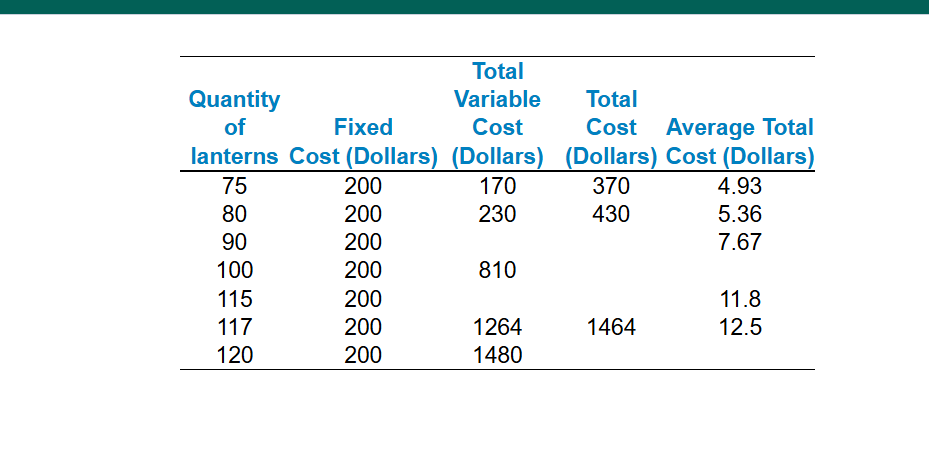
Average fixed costs of production
falls as long as output is increased.
Long run costs are
Uminus−shaped
because
of economies and diseconomies of scale.
Which of the following statements is
false?
Marginal cost will equal average total cost when marginal cost is at its lowest point.
Question content area
Part 1
If average total cost is $50 and average fixed cost is $15 when output is 20 units, then the firm's total variable cost at that level of output is
700
Question content area
Part 1
Golda Rush quit her job as a manager for Home Depot to start her own hair dressing salon, Goldilocks. She gave up a salary of $40,000 per year, invested her savings of $30,000 (which was earning 5 percent interest) and borrowed $10,000 from a close friend, agreeing to pay 5 percent interest per year. In her first year, Golda spent $18,000 to rent a salon, hired a part-time assistant for $12,000 and incurred another $15,000 in expenses on equipment and hairdressing material. Based on this information, what is the amount of her explicit costs for the first year?
$45,500
The law of diminishing marginal returns
explains why the average total cost and marginal cost curves are
Uminus−shaped
in the short run.
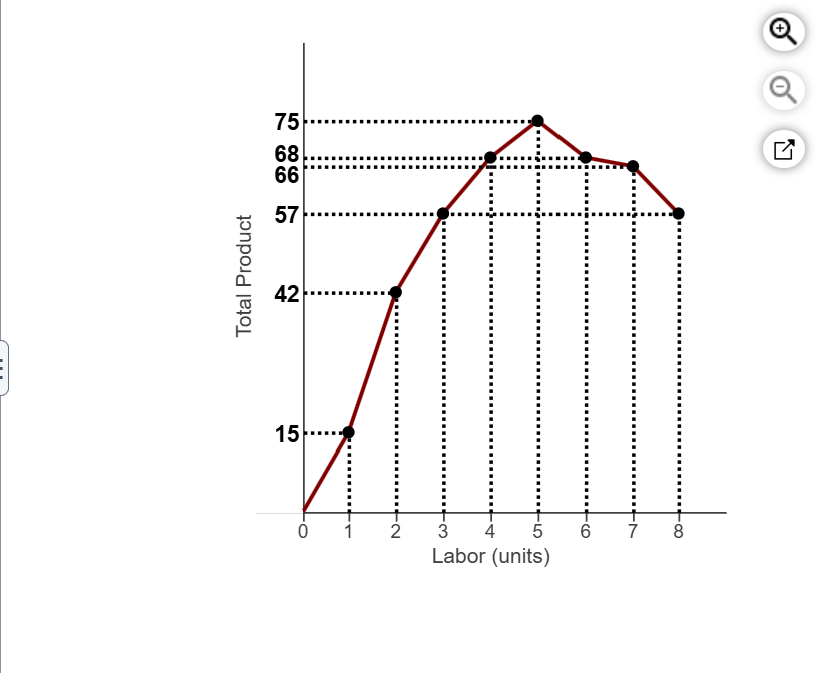
Refer to the diagram to the right. The marginal product of the 3rd worker is
15
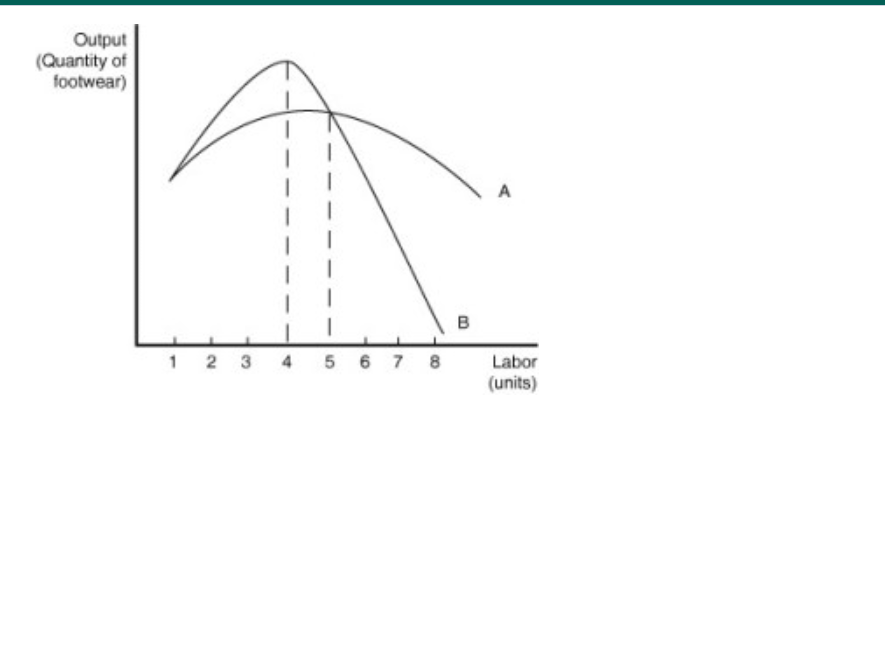
Fancy Footwear manufactures shoes. The figure to the right shows Fancy Footwear's marginal product of labor and average product of labor curves in the short run.
Which of the following statements correctly describes the curves in the figure?
The marginal product of labor curve is represented by curve B and the average product of labor curve is represented by curve
A.
Which of the following equations is correct?
AFC + AVC = ATC
If, when a firm doubles all its inputs, its average cost of production decreases, then production displays
economies of scale.
Question content area
Part 1
The long run average cost curve shows
the lowest average cost of producing every level of output in the long run.
Question content area
Part 1
If another worker adds 9 units of output to a group of workers who had an average product of 7 units, then the average product of labor
will increase.
Economic cost of production differ from accounting costs in that
economic cost adds the opportunity cost of a firm using its own resources while accounting cost does not.
Question content area
Part 1
A characteristic of the long run is
all inputs can be varied.
Vipsana's Gyros House sells gyros. The cost of ingredients (pita, meat, spices, etc.) to make a gyro is $2.00. Vipsana pays her employees $60 per day. She also incurs a fixed cost of $120 per day. Calculate Vipsana's average fixed cost per gyro when she produces 50 gyros using two workers?
Part 2
$2.40
The production function shows
the maximum output that can be produced from a set of inputs.
Question content area
Part 1
Which of the following is an example of positive technological change?
A firm's workers participate in a training program designed to increase the number of surf boards they can produce per day.
Red Stone Creamery currently hires 5 workers. When it added a 6th worker, its output actually fell. Which of the following statements is true?
The marginal product of the sixth worker must be negative.
Question content area
Part 1
If the marginal cost curve is below the average variable cost curve, then
average variable cost is decreasing.
The law of diminishing marginal returns states
that at some point, adding more of a variable input to a given amount of a fixed input, will cause the marginal product of the variable input to decline.
Implicit costs can be defined as
.
the
nonminus−monetary
opportunity cost of using the firm's own resources.
Vipsana's Gyros House sells gyros. The cost of ingredients (pita, meat, spices, etc.) to make a gyro is $2.00. Vipsana pays her employees $60 per day. She also incurs a fixed cost of $120 per day. Calculate Vipsana's total cost per day when she produces 50 gyros using two workers?
$220
Marginal cost is equal to the
change in total cost divided by the change in output.
Vipsana's Gyros House sells gyros. The cost of ingredients (pita, meat, spices, etc.) to make a gyro is $2.00. Vipsana pays her employees $60 per day. She also incurs a fixed cost of $120 per day. What is Vipsana's total cost per day when she does not produce any gyros and does not hire any workers?
120
The marginal product of labor is defined as
the additional output that results when one more worker is hired, holding all other resources constant.
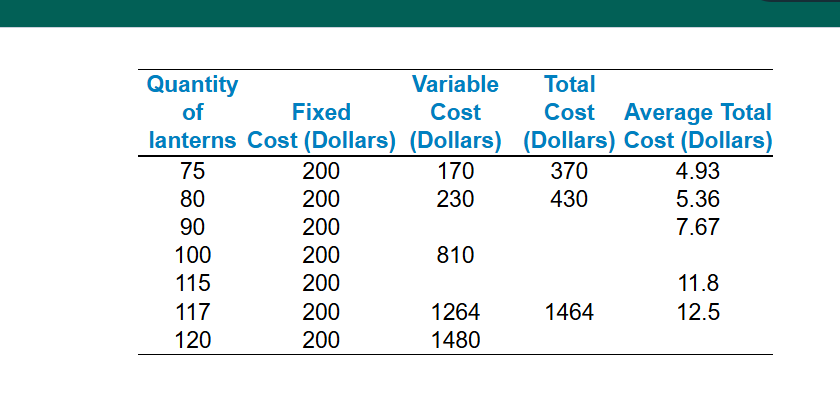
Refer to the table to the right which shows cost data for Lotus Lanterns, a producer of whimsical night lights.
What is the average total cost of production when the firm produces 120 lanterns?
Part 2
$12.3
Which of the following is an example of a long-run adjustment?
Walmart builds another Supercenter.
Question content area
Part 1
Golda Rush quit her job as a manager for Home Depot to start her own hair dressing salon, Goldilocks. She gave up a salary of $40,000 per year, invested her savings of $30,000 (which was earning 5 percent interest) and borrowed $10,000 from a close friend, agreeing to pay 5 percent interest per year. In her first year, Golda spent $18,000 to rent a salon, hired a part-time assistant for $12,000 and incurred another $15,000 in expenses on equipment and hairdressing material. Based on this information, what is the amount of her implicit costs for the first year?
$41,500
The explicit cost of production is also called
accounting cost.
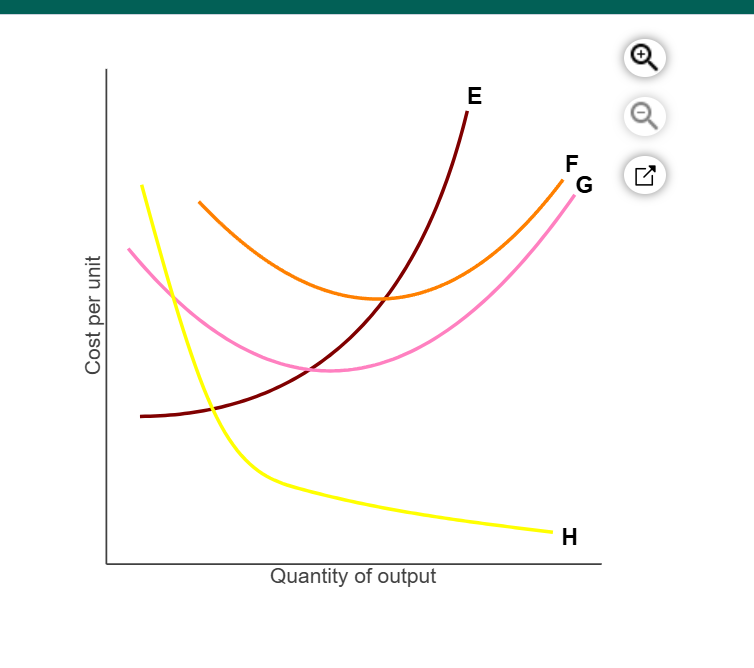
Refer to the diagram to the right. Identify the curves in the diagram.
E = marginal cost curve; F = average total cost curve; G = average variable cost curve; H = average fixed cost curve.